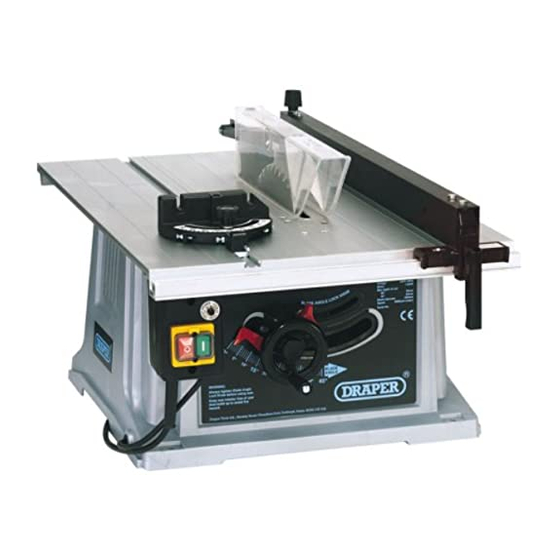Draper BTS251 Руководство по эксплуатации - Страница 6
Просмотреть онлайн или скачать pdf Руководство по эксплуатации для Пила Draper BTS251. Draper BTS251 20 страниц. 10"

WARNING
For your own safety, do not operate your saw until it is
completely assembled and installed according to the
instructions....and until you have read and understood
the following: All safety rules
Assembly procedures
Adjustment procedures
Maintenance
Basic operations
Operating controls
1.
STABILITY.
The saw must be bolted down. There may be a
tendency for the saw to tip over or move during
certain cutting operations, such as, cutting
extremely large heavy panels or long heavy
boards.
2.
MINIMIZE POTENTIAL ACCIDENTS.
Most accidents are caused by FAILURE TO
FOLLOW SET UP AND OPERATION
INSTRUCTIONS.
Avoid awkward hand positions, where a sudden
slip could cause a hand to move into a saw blade
or other cutting tool. Never reach behind, or
around, the cutting tool with either hand to hold
down the workpiece, or for any other reason. DO
NOT PLACE FINGERS OR HANDS IN THE PATH
OF THE SAW BLADE.
3.
Never reach under your machine when operating
or make any adjustments when it is running.
4.
Turn the saw 'OFF' and disconnect the power
supply when changing the cutting tool, removing
or replacing the blade guard, or making any
adjustments.
5.
Always maintain control of the workpiece. DO
NOT 'LET GO' of the workpiece until the machine
has stopped.
6.
When removing short workpieces, or cleaning
up around the table, be sure the saw is switched
'OFF'.
7.
Never turn the saw 'ON' before clearing the table
of all tools, wood scraps, etc., except the
workpiece and related feed or support devices
for the operation.
8.
When moving the saw, disconnect power supply.
9.
Never hold onto or touch the 'free end' of the
workpiece or a 'free piece' that is cut off, while
power is 'ON' and/or the saw blade is rotating.
10. If you stall or jam the saw blade in the
workpiece, turn power 'OFF', remove the
workpiece from the saw blade and check to see
if the saw blade is parallel to the table slots or
grooves and if the riving knife is in alignment
with the saw blade. If ripping at the time, check
to see if the rip fence is parallel with the saw
blade. Adjust as indicated in this manual.
WARNING: Do not allow familiarity (gained from
frequent use of your saw) to become
commonplace. Always remember that a careless
fraction of a second is sufficient to inflict severe
injury.
11. MAKE SURE YOUR FINGERS DO NOT CONTACT
THE TERMINALS OF THE POWER PLUG when
installing or removing from the mains power supply.
ADDITIONAL TABLE SAW
SAFETY RULES
12. KICKBACKS - THEIR CAUSE.
Kickbacks can cause serious injury. A kickback
occurs when a part of the workpiece binds
between the saw blade and the rip fence or
another object rises from the table and is thrown
towards the operator. Kickbacks can be avoided
by attention to the following conditions.:
13. KICKBACK - HOW TO AVOID THEM AND
PROTECT YOURSELF FROM POSSIBLE
INJURY.
a)
Be certain that the saw blade is parallel to
the rip fence.
b)
Do not rip by applying the feed force to the
section of the workpiece that will become
the cut-off (free) piece. Feed force when
ripping should always be applied between
the saw blade and the fence....use a push-
stick for short work or less than 6" wide.
c)
Keep saw blade guard, riving knife and
anti-kickback pawls in place and operating
properly. The riving knife must be in
alignment with the saw blade and the pawls
must stop a kickback once it has started.
Check their action before using for ripping
timber.
d)
Plastic and composition (like hardboard)
materials may be cut on your saw. However,
since these are usually quite hard and
slippery, the anti-kickback pawls may not
stop a kickback. Therefore, be especially
careful to follow proper setting up and
cutting procedures before ripping.
14. Do not leave a long board (or other workpiece)
unsupported so the spring of the board causes it
to shift on the table. Provide proper support for
the workpiece, based on its size and the type of
operation to be performed. Hold the work firmly
against the fence and down against the table
surface.
15. Never use a length stop on the free end of the
workpiece when cross cutting. Never hold onto
or touch the free end of the workpiece when
cross cutting, or a free piece that is cut off when
ripping while power is 'ON' and/or the saw blade
is rotating. In short, the cut-off piece in any
'through-sawing' (cutting completely through the
workpiece) operation must never be confined - it
must be allowed to move laterally.
16. IF YOUR SAW MAKES AN UNFAMILIAR NOISE OR
IF IT VIBRATES EXCESSIVELY, CEASE
OPERATING IMMEDIATELY UNTIL THE SOURCE
HAS BEEN LOCATED AND THE PROBLEM
CORRECTED.
17. EXTENSION LEADS
The use of any extension lead will cause some
loss of power. To keep this to a minimum and to
prevent over heating and motor burn-out, use the
table to determine the minimum size of
extension cable required. Use only extension
leads which have a 3-pin plug and 3-pin sockets
which accept the tools plug.
- 5 -
